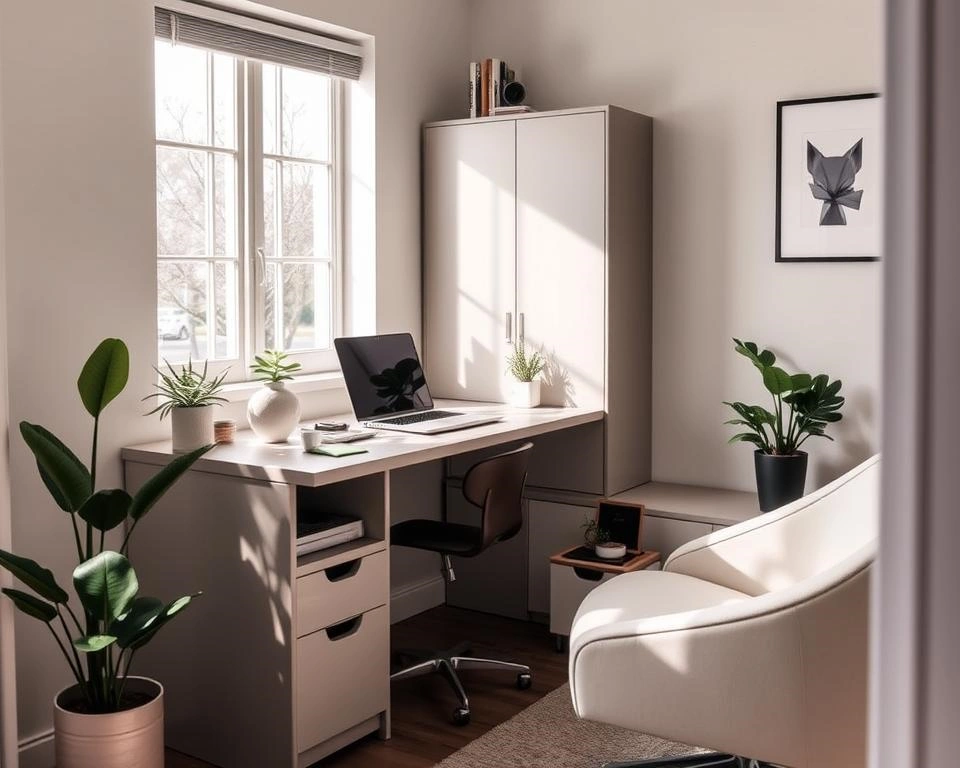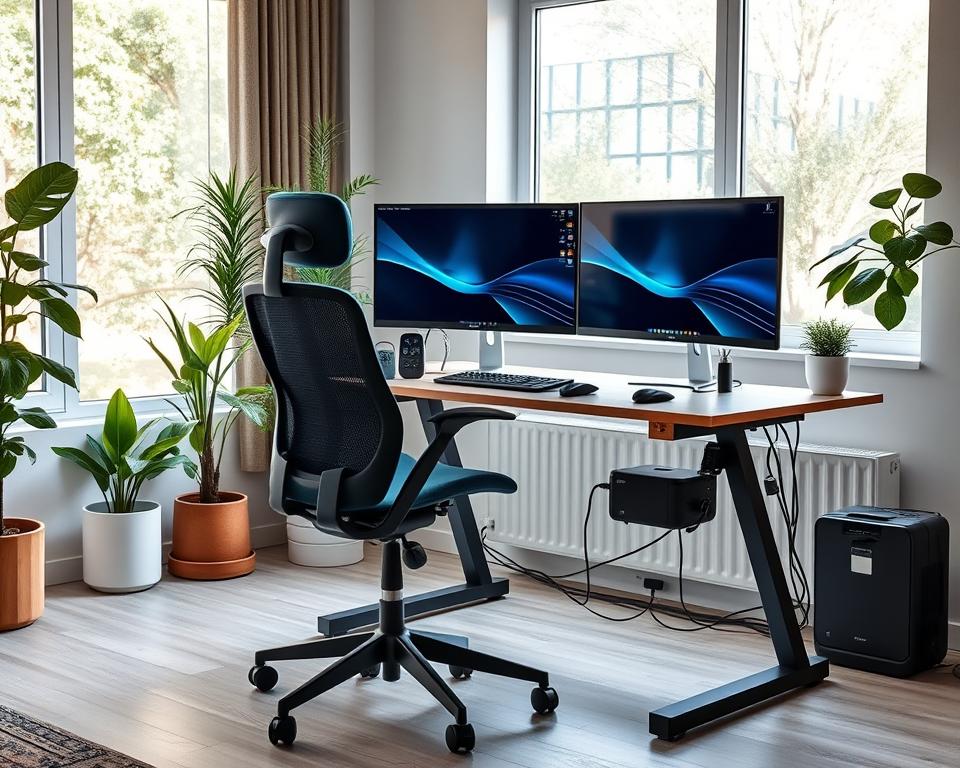Did you know a well-designed home office can cut the risk of musculoskeletal disorders by up to 40% for remote medical workers? With more people working from home, making your office space stress-free is key. Clutter, bad lighting, and old tech can hurt your mental health and work output. But, with the right home office setup tips, you can make your home office a place of calm and focus.
Remote work is on the rise, with 62% of workers saying they’re more productive at home. Whether you’re a doctor, freelancer, or small business owner, a well-set home office can bring big benefits. Freelancers see a 25% jump in job happiness, and small business owners spend 50% less time looking for documents.
Understanding the Impact of Home Office Environment on Mental Health
The home office environment has a significant impact on mental health, and it is important to understand how various factors within this space can influence well-being. From lighting and furniture to noise levels and organization, the way in which we set up our home offices can either support or hinder our mental health.
One key factor to consider is the amount of natural light in the home office. Natural light has been shown to have a positive impact on mood and productivity, so it is important to position your desk near a window or invest in quality lighting fixtures. Additionally, incorporating elements of nature such as plants can further enhance the overall atmosphere of the space.
Another important aspect of the home office environment is the furniture. An ergonomic chair and desk setup can help prevent back and neck pain, which can contribute to increased stress and discomfort. It is also important to ensure that the workspace is organized and free of clutter, as a chaotic environment can lead to feelings of overwhelm and anxiety.

Noise levels can also play a role in mental health, as loud or distracting sounds can make it difficult to focus and concentrate. Consider using noise-canceling headphones or a white noise machine to create a more peaceful and productive work environment.
In addition to physical factors, it is important to consider the psychological impact of the home office environment. Setting boundaries between work and personal life is crucial in order to prevent burnout and maintain a healthy work-life balance. Taking breaks, practicing mindfulness, and finding ways to disconnect from work at the end of the day can all contribute to better mental health while working from home.
Studies show remote workers are 13% more productive than office workers. Yet, 73% say remote work improves their life balance. But, we must tackle loneliness and burnout to keep remote workers well.
Overall, the home office environment plays a critical role in mental health, and it is essential to create a space that supports well-being and productivity. By paying attention to factors such as lighting, furniture, noise levels, and psychological boundaries, we can optimize our home office environments for improved mental health and overall happiness.
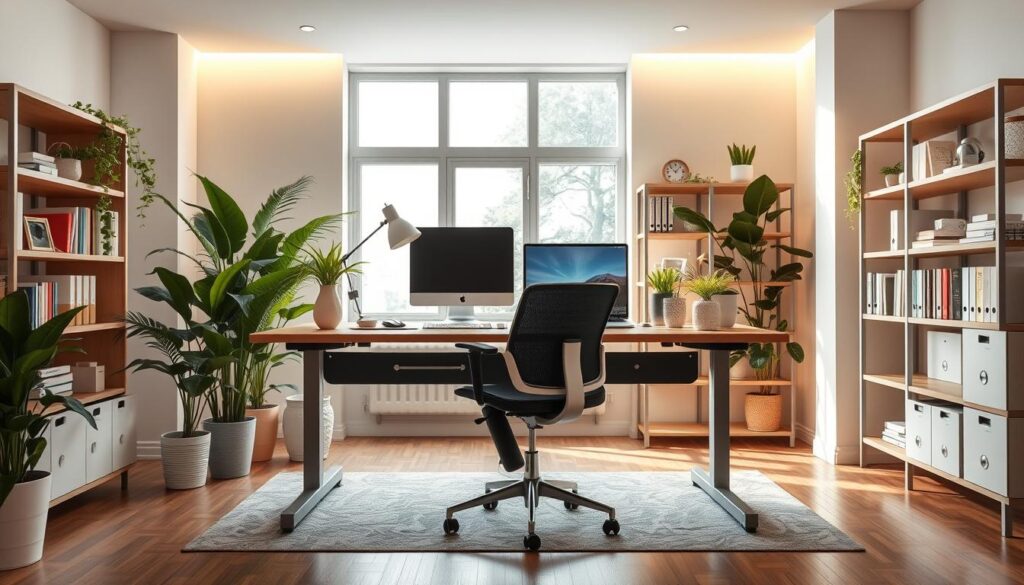
“The physical work environment significantly influences job satisfaction and productivity.”
Productive Home Office Setup Essential Elements
Creating a productive home workspace is essential for maintaining focus and efficiency while working from home. Having a designated area where you can concentrate and be free from distractions is crucial for your productivity. Whether you are a remote worker, freelancer, or entrepreneur, having a well-organized and optimized workspace is essential for success.
Here are some essential elements to consider when setting up your home workspace:
1. Comfortable and ergonomic furniture: Invest in a good quality ergonomic chair and a spacious desk that suits your working style and preferences. Make sure your chair provides proper support for your back and neck to prevent discomfort and pain.
2. Good lighting: Natural light is ideal for a home workspace, as it can help improve mood and increase productivity. If natural light is limited, consider adding in additional lighting sources such as desk lamps or overhead lighting to provide a well-lit working environment.
3. Organized and clutter-free space: Keep your workspace organized and free from clutter to help maintain focus and reduce distractions. Utilize storage solutions such as shelves, drawers, and filing cabinets to keep your workspace tidy and efficient.
4. Tech essentials: Ensure that you have all the necessary technology and equipment for your work, such as a reliable computer, high-speed internet connection, and a printer. Make sure your devices are up to date and in good working condition to avoid any technical issues.
5. Personal touches: Add personal touches to your workspace to make it feel like your own. Decorate with plants, photos, and motivational quotes to create a comfortable and inspiring environment that reflects your personality.
6. Noise-cancelling headphones: If you are easily distracted by noise or have to work in a busy household, consider investing in noise-cancelling headphones to help create a quiet and focused working environment.
7. Proper ventilation: Ensure that your workspace has proper ventilation to maintain a comfortable and healthy working environment. Keep windows open for fresh air flow or invest in a fan or air purifier to keep the space well ventilated.
By incorporating these essential elements into your home workspace, you can create a productive and efficient environment that will help you stay focused and motivated while working from home. Remember that everyone’s workspace preferences are different, so feel free to customize your space to suit your needs and style. With a well-designed and optimized home workspace, you can enhance your productivity and make the most out of your workday.
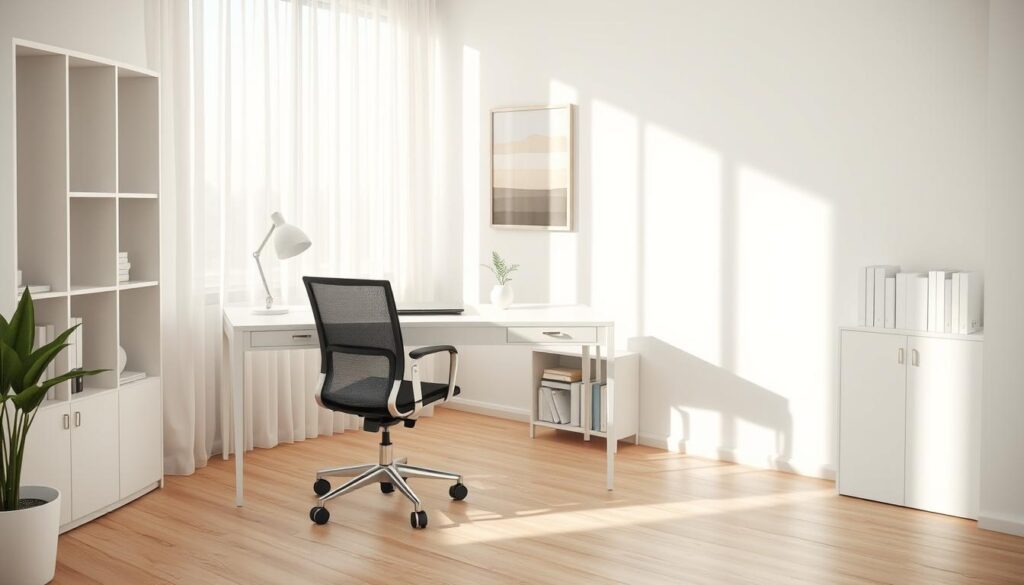
“A well-designed home office can significantly improve productivity and mental health.”
Stress-Free Home Office Setup
Making your home office a stress-free zone is key for staying productive and feeling good. Start by cleaning up your space and checking each item to see if it’s needed. A messy desk can make you stressed and less productive, with people wasting 4.3 hours a week searching for lost papers.
Choose furniture that’s good for your body and place your desk in a spot that helps you focus. Having a clear work area boosts your focus and productivity. Add things like plants, art, or a vision board to make your space look good and feel calm. Plants can make your office more peaceful and productive.
Make your office your own by adding things that show your style and what you like to do. A comfy and laid-back office can make you more productive. Think about things like light, temperature, and air quality to make a space that’s good for you and less stressful. Natural light can make you happier, less stressed, and more productive, with up to 40% more work done by those with natural light.
- Set up cleaning routines to keep your space neat Studies show that clean offices can reduce stress by 25%, making a tidy space more peaceful.
- Use furniture that does more than one thing to save space Using furniture that does multiple things can make your office more organized and efficient, with 20% more storage than regular furniture.
- Add things that make you happy to your office Listening to soothing music while you work can help you stay focused.
By making your home office a calm and organized place, you can feel better and work better.,,
“A calm and organized workspace can lead to a clear and focused mind, empowering you to tackle your tasks with ease.”
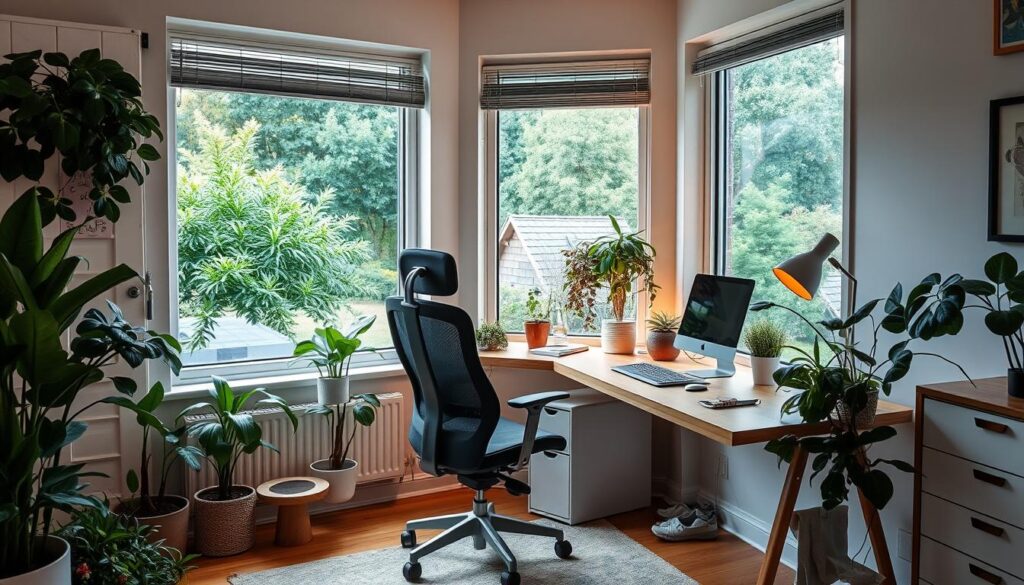
Home Office Setup Ergonomic Solutions
A productive home office setup is more than just a comfy spot. Ergonomic solutions are key to staying comfortable and avoiding strain during long hours. By using ergonomic design, you can boost your productivity and well-being at home.
First, get an ergonomic chair that supports your back and adjusts well. Choose one that keeps your spine straight and stops you from slouching. Add an adjustable standing desk to improve your posture and cut down on back pain. Don’t forget ergonomic mice, keyboards, and a footrest to keep your hands, wrists, and feet right.
It’s also important to place your monitor correctly for ergonomic office design. Your computer screen should be about an arm’s length away, with the top at or slightly below eye level. This prevents neck and eye problems. If you use a laptop, get an external keyboard and mouse for a better setup.
Adding these ergonomic solutions to your home office can greatly improve your comfort and reduce strain. By focusing on ergonomics, you create a healthier and more sustainable work space. This helps your long-term health and career success.
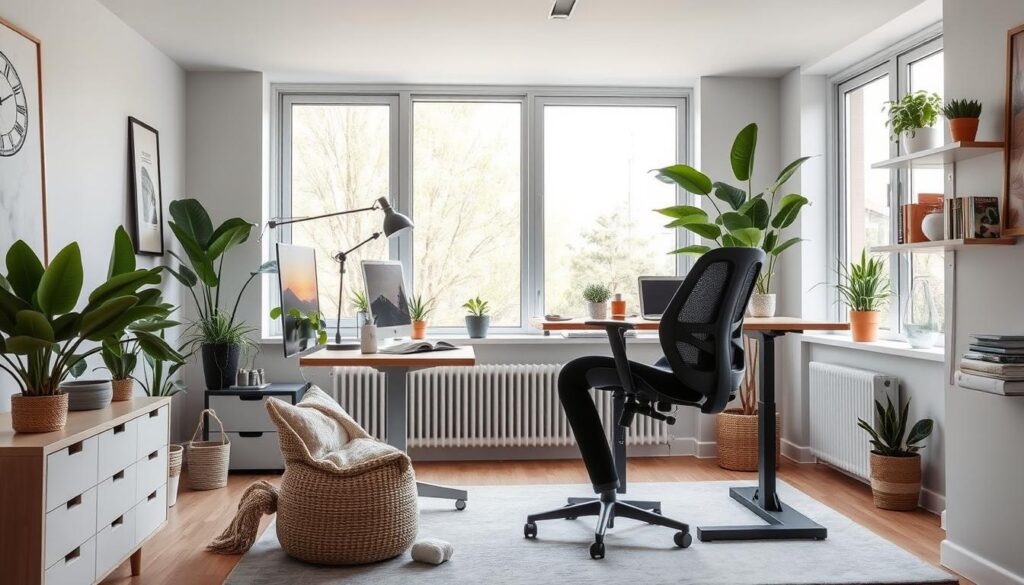
“Investing in ergonomic solutions is not just about comfort, but also about long-term health and productivity. A well-designed workspace can make a significant difference in your daily work experience.”
Nature and Wellness Elements in Home Office Setup
Turning your home office into a calm space is easy with nature and wellness. Bringing greenery indoors makes your space feel better and cleaner. This helps you work better and feel more relaxed.
Choose easy-to-care-for plants like peace lilies or snake plants. They do well in little light. A study found people with plants and natural light at work were happier and more productive.
Add a small water feature, an essential oil diffuser, or natural fiber textiles to calm your space. These things can make you feel less stressed and happier in your office. Mindfulness and exercise in a wellness room can also improve your mood and focus.
Another way to incorporate nature into your home office setup is by incorporating natural materials such as wood, stone, or bamboo into your decor. Opt for a wooden desk or shelves, a stone paperweight, or a bamboo filing cabinet to create a more organic and earthy feel in your workspace.
In addition to incorporating elements of nature, it’s also important to prioritize your wellness in your home office setup. Make sure you have proper lighting to reduce eye strain and enhance your mood. Opt for natural light whenever possible and consider adding a desk lamp with a daylight bulb if needed.
It’s also important to prioritize ergonomics in your home office setup to prevent strain and discomfort. Invest in a comfortable chair with good back support, a height-adjustable desk, and a footrest to ensure proper posture and reduce the risk of musculoskeletal issues.
Lastly, don’t forget to incorporate elements of relaxation and mindfulness into your home office setup. Consider adding a small meditation corner with a cushion or chair, a diffuser with essential oils, or a mini fountain to create a peaceful and calming atmosphere in your workspace.
By incorporating elements of nature and wellness into your home office setup, you can create a more inviting and productive work environment that promotes both mental and physical well-being. Take the time to personalize your space with these elements to create a workspace that supports your overall health and happiness.
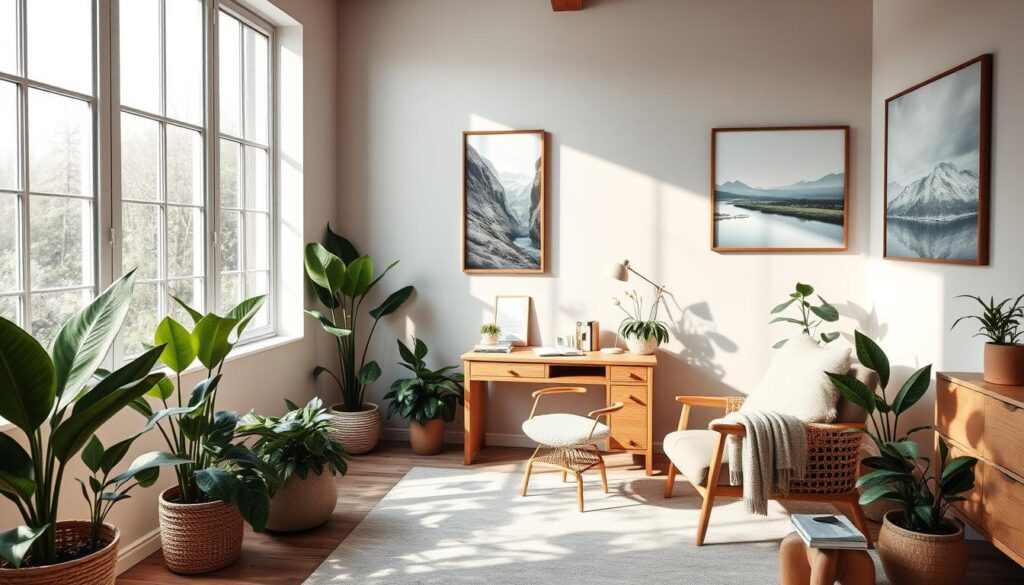
A study showed workers near windows and plants were happier. Adding colors, scents, and music to your office can also make you feel better and work better.
“Bringing nature into our living and working spaces can have a profound impact on our mental and physical well-being.” – Environmental Psychologist, Dr. Sally Augustin
By embracing these wellness-focused elements, you can make your home office a stress-free haven. It will help you work better, focus more, and feel better overall. Making a wellness room quiet and adding adjustable lights can also help.
Smart Storage and Organization Strategies
Keeping your home office tidy can make you more productive and less stressed. It’s key to have good storage and organization for a clean and calm workspace.
Start by checking out your office and making a list of what you use most. This helps you figure out what storage you really need and how to arrange things for the best use. Look into furniture that can hide things, which is great for small areas.
Set up a smart filing system with colors and labels to make finding documents easy. Use shelves that go up the wall to save floor space and keep things neat.
- Use dividers in drawers to keep office supplies in order, making it easier to find what you need.
- Keep cables tidy to avoid clutter and make your office look better.
Make cleaning up a regular habit to clear your mind and boost focus. Try setting up different areas for different tasks to help you stay on track and avoid distractions.
“The true sign of intelligence is not knowledge but imagination.” – Albert Einstein
Smart storage and organization can turn your home office into a calm and attractive place. Add a simple style, personal touches, and tools to make it both beautiful and functional.
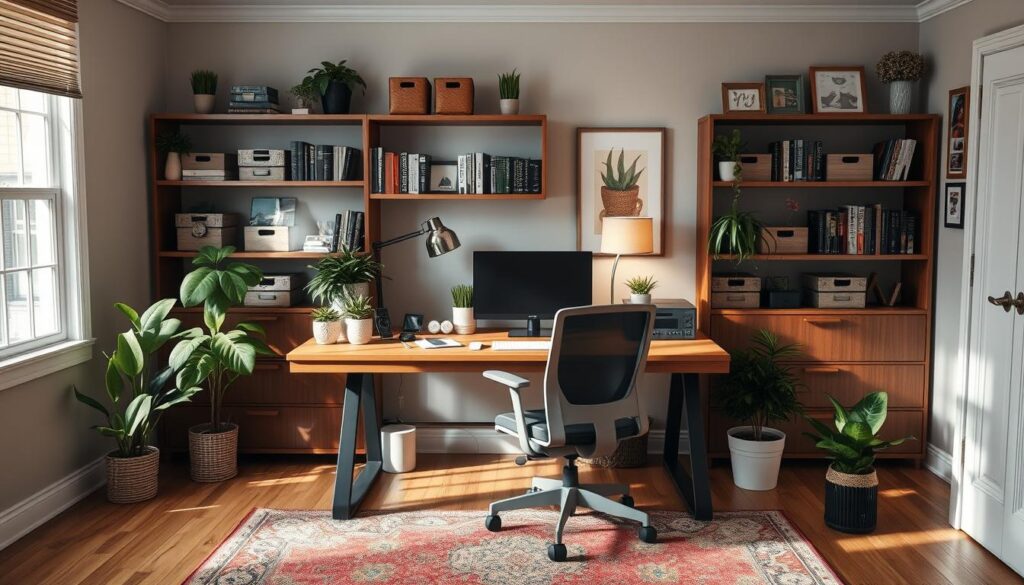
Technology Management and Digital Organization
Managing technology well is key to a productive workspace and a stress-free home office. A good cable management system helps reduce clutter and safety risks. A USB charging station keeps devices organized and within reach, improving your workspace.
Placing computer gear near outlets makes your home office setup smoother. Using digital tools like cloud storage and project management software boosts efficiency and cuts down stress. Keeping your tech up to date prevents annoying problems, making your work smoother.
“Private, soundproof office pods like hushMeet create a quiet environment, reducing auditory stressors and boosting focus and productivity.”
One key aspect of technology management in a home office setup is establishing a digital organization. This involves creating a seamless digital workflow, utilizing collaboration tools and platforms to facilitate communication and collaboration among team members, and implementing project management software to track progress and streamline processes.
By implementing effective technology management and establishing a digital organization in your home office setup, you can increase productivity, improve communication and collaboration among team members, and enhance overall efficiency and effectiveness. Additionally, you can stay ahead of the competition and adapt to changing market conditions and customer demands.
Technology management and digital organization are essential components of a successful home office setup. By implementing these strategies, you can leverage the power of technology to drive your business forward and achieve your goals. So, embrace technology, streamline your digital workflow, and watch your home office thrive.
These ergonomic solutions make your home office look better and feel more comfortable. By using these tech management and digital organization tips, you can make a productive workspace and enjoy a stress-free home office.
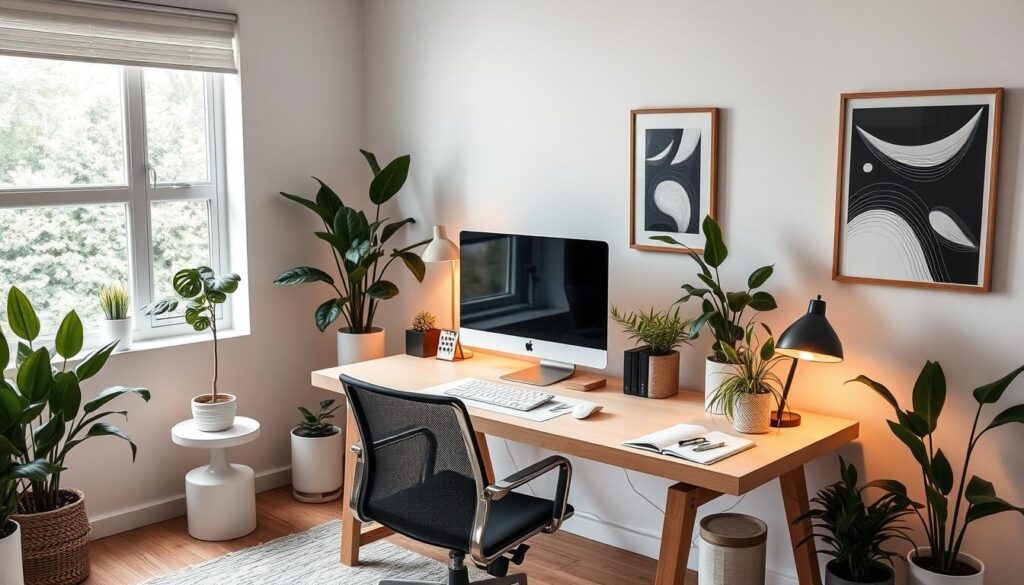
- Efficient cable management reduces visual clutter and potential hazards.
- USB charging stations keep small devices organized and accessible.
- Positioning equipment near outlets streamlines the home office setup.
- Digital organization tools enhance workflow efficiency and reduce stress.
- Regular technology updates and maintenance prevent frustrating issues.
By following these tips, you can make a home office that’s both productive and stress-free. It will support your well-being and career success.

Establishing Boundaries Between Work and Personal Life
Setting boundaries between work and personal life is crucial for maintaining our overall well-being and preventing burnout. When work constantly bleeds into our personal time, it can lead to increased stress, decreased productivity, and strained relationships with loved ones.
One important aspect of establishing boundaries is setting designated work hours. Whether you work from home or in an office, having a set schedule for when you will be working can help you create a clear separation between work and personal time. This means avoiding checking work emails or taking work calls outside of these hours.
It’s also important to create physical boundaries between work and personal spaces. If you work from home, try to designate a specific area as your workspace and avoid working from the couch or bed. This will help signal to your brain that when you are in that space, you are focused on work, and when you leave that space, you can relax and unwind.
Another key aspect of establishing boundaries is learning to say no. It’s important to set limits on how much work you take on and to prioritize self-care and downtime. This may mean setting boundaries with your boss or colleagues about your availability outside of work hours, or being selective about taking on additional projects or responsibilities.
Ultimately, establishing boundaries between work and personal life is about prioritizing your well-being and setting limits to protect your mental and emotional health. By creating a clear separation between work and personal time, you can prevent burnout, improve your productivity, and cultivate a healthier work-life balance.

Source Links
- Create a Home Office with These 10 Tips – https://www.mbopartners.com/blog/how-manage-small-business/create-a-home-office-with-these-10-tips/
- Create a Calm Work From Home Space – https://yellowtail.tech/blog-contents/how-to-make-your-work-from-home-environment-stress-free/
- Creating your home office with mental health in mind – https://remote.com/blog/home-office-mental-health
- The Impact of Remote Working on Mental Health | Horton International – https://hortoninternational.com/the-impact-of-remote-working-on-mental-health-pros-and-cons/
- Creating an Effective Home Office Setup – https://getofficely.com/blog/creating-an-effective-home-office-setup
- How to Create the Perfect Home Office Setup for Remote Work – https://www.rovetravel.com/blog/create-perfect-home-office-setup-for-remote-work
- Organization Tips for Creating a Stress-free Home Office | House to Home Organizing – https://www.h2horganizing.com/blog/2022/10/20/organization-tips-for-creating-a-stress-free-home-office
- Create a Stress-Free Home Office Working Environment – Boca Terry – https://wholesale.bocaterry.com/create-a-stress-free-home-office-working-environment/
- How to Create a Stress-Free Home Office | TeamGantt – https://www.teamgantt.com/blog/how-to-work-from-home-and-get-stuff-done-while-still-preserving-family-peace-and-normal-social-behavior
- Office ergonomics: Your how-to guide – https://www.mayoclinic.org/healthy-lifestyle/adult-health/in-depth/office-ergonomics/art-20046169
- 10 Office Ergonomics Tips to Help You Avoid Fatigue – https://ergo-plus.com/office-ergonomics-10-tips-to-help-you-avoid-fatigue/
- How To Design A Wellness Room In The Workplace | Wellable – https://www.wellable.co/blog/wellness-room-in-the-workplace/
- Workplace Wellness | 5 Tips for Incorporating Workplace Wellness into Your Office Design – https://origameo.hbreavis.com/workplace-wellness-5-tips-for-incorporating-workplace-wellness-into-your-office-design/
- Simple Office Storage Ideas – https://www.cubesmart.com/blog/features-and-types/simple-office-storage-ideas/
- Get Organized Fast: 100 Tips for a Stress-Free Home – https://justorganized.org/100-quick-tips-to-organize-your-whole-home/
- Organize Your Home Office for Maximum Productivity – https://myhappyhome.biz/organize-your-home-office-simple-steps/
- Curbing digital stress in a hybrid work world… – https://hushoffice.com/en-us/curbing-digital-stress-in-a-hybrid-work-world/
- 10 Tips in Building a Productive Home Office Setup for Remote Work – https://www.linkedin.com/pulse/10-tips-building-productive-home-office-setup-remote-work-magatao
- Setting healthy boundaries at work – Workplace Strategies for Mental Health – https://www.workplacestrategiesformentalhealth.com/resources/setting-healthy-boundaries-at-work
- How to Set Boundaries for Work-Life Balance – https://www.business.com/articles/work-life-boundaries/
- How to Set Boundaries Between Work and Home Life – https://www.remote-work.io/how-to-set-boundaries-between-work-and-home-life/


